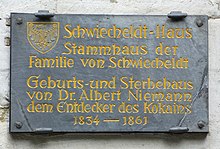Albert Niemann (chemist)
In 1849 he began an apprenticeship at the town hall pharmacy in Göttingen, where, starting in 1852, he was a Ph.D. student at the George August University.
[1] In the 19th century, there was great interest among European chemists in the effects of coca leaves discovered in Latin America.
In 1855 the chemist Friedrich Gaedcke had published a treatise on an active alkaloid extract of the coca leaf he called erythroxyline, after the genus Erythroxylum, from which cocaine-rich leaves are obtained.
[1] He wrote of the alkaloid's “colourless transparent prisms” and said that, “Its solutions have an alkaline reaction, a bitter taste, promote the flow of saliva and leave a peculiar numbness, followed by a sense of cold when applied to the tongue.” He published his finding in 1860 in his dissertation titled Über eine neue organische Base in den Cocablättern (On a New Organic Base in the Coca Leaves).
[6] In 1860, Niemann described the properties of mustard gas as: Sie besteht darin, daß selbst die geringste Spur, die zufallig auf irgend eine Stelle der Haut kommt, anfangs zwar keinen Schmerz hervorruft, nach Verlauf einiger Stunden aber eine Rötung derselben bewirkt und bis zum folgenden Tage eine Brandblase hervorbringt, die sehr lange eitert und außerordentlich schwer heilt , unter Hinterlassung starker Narben.

